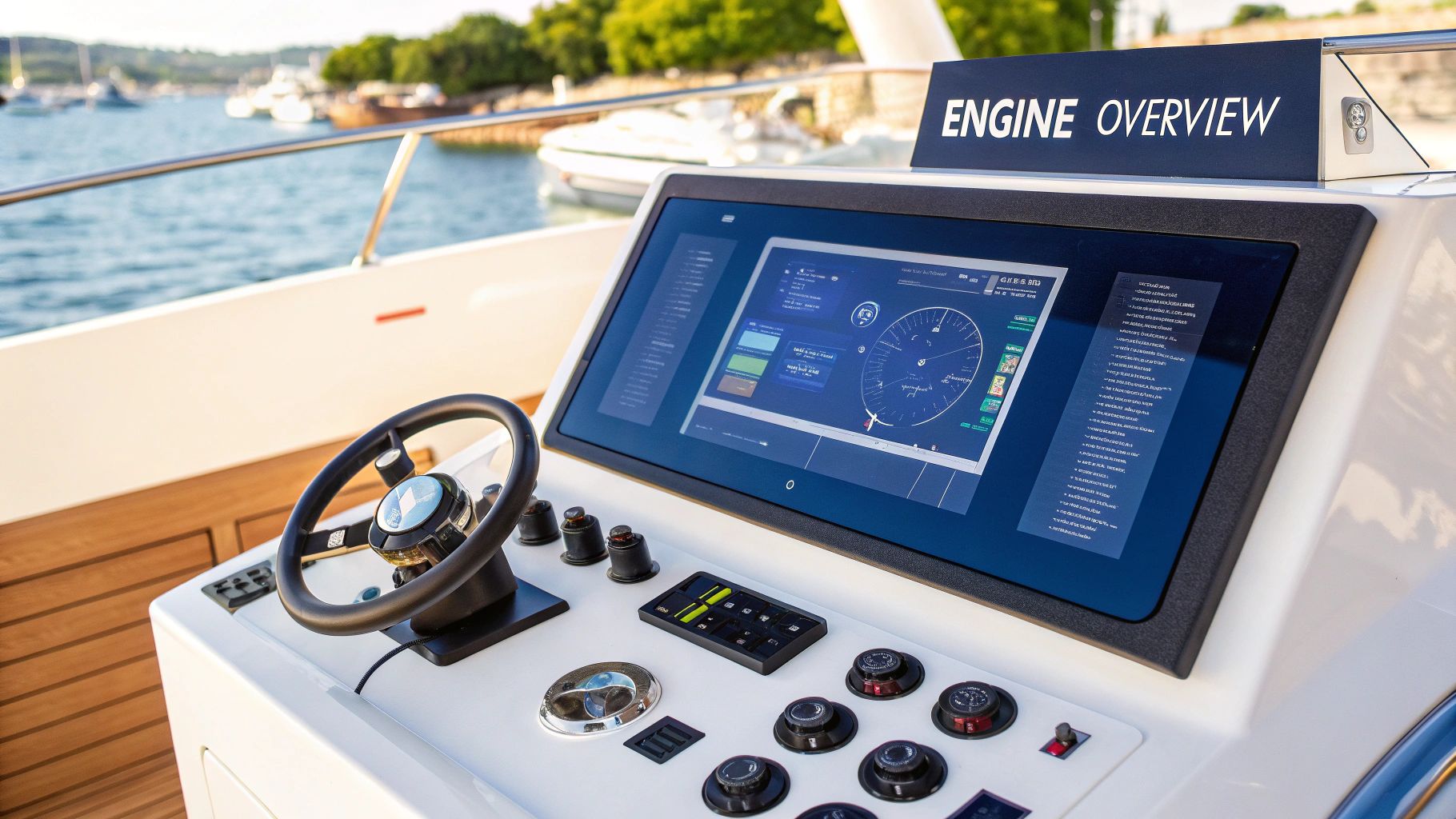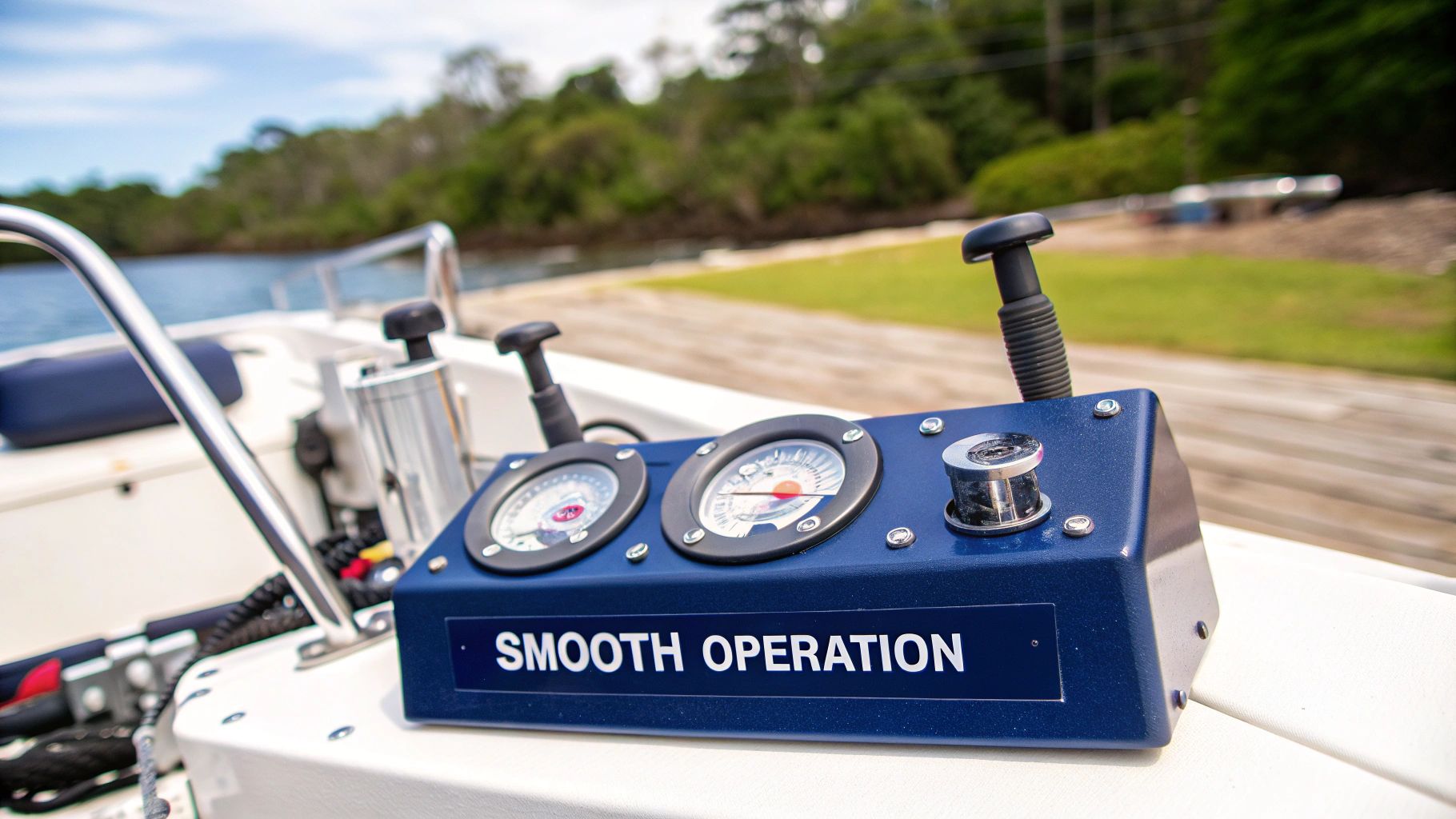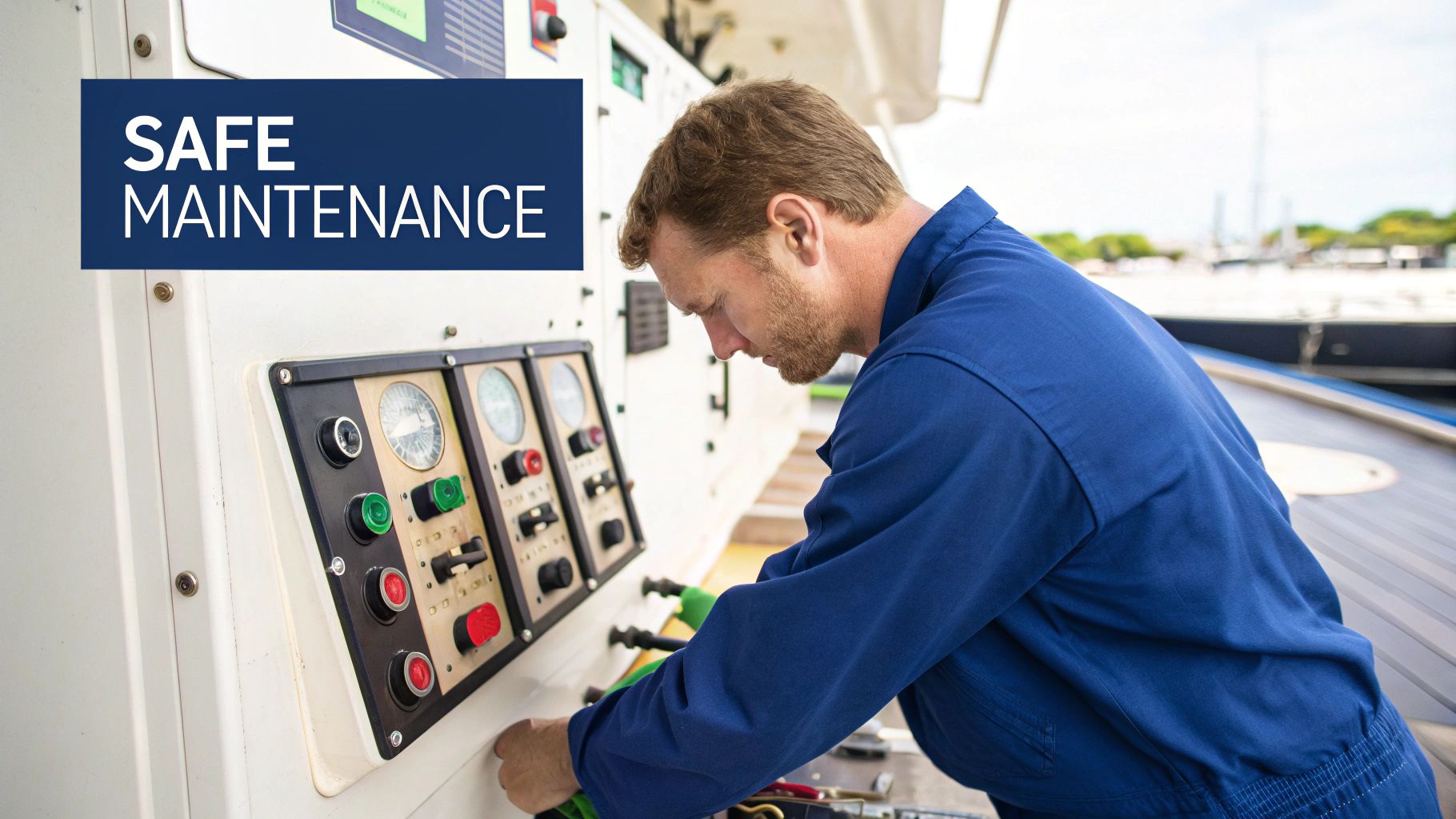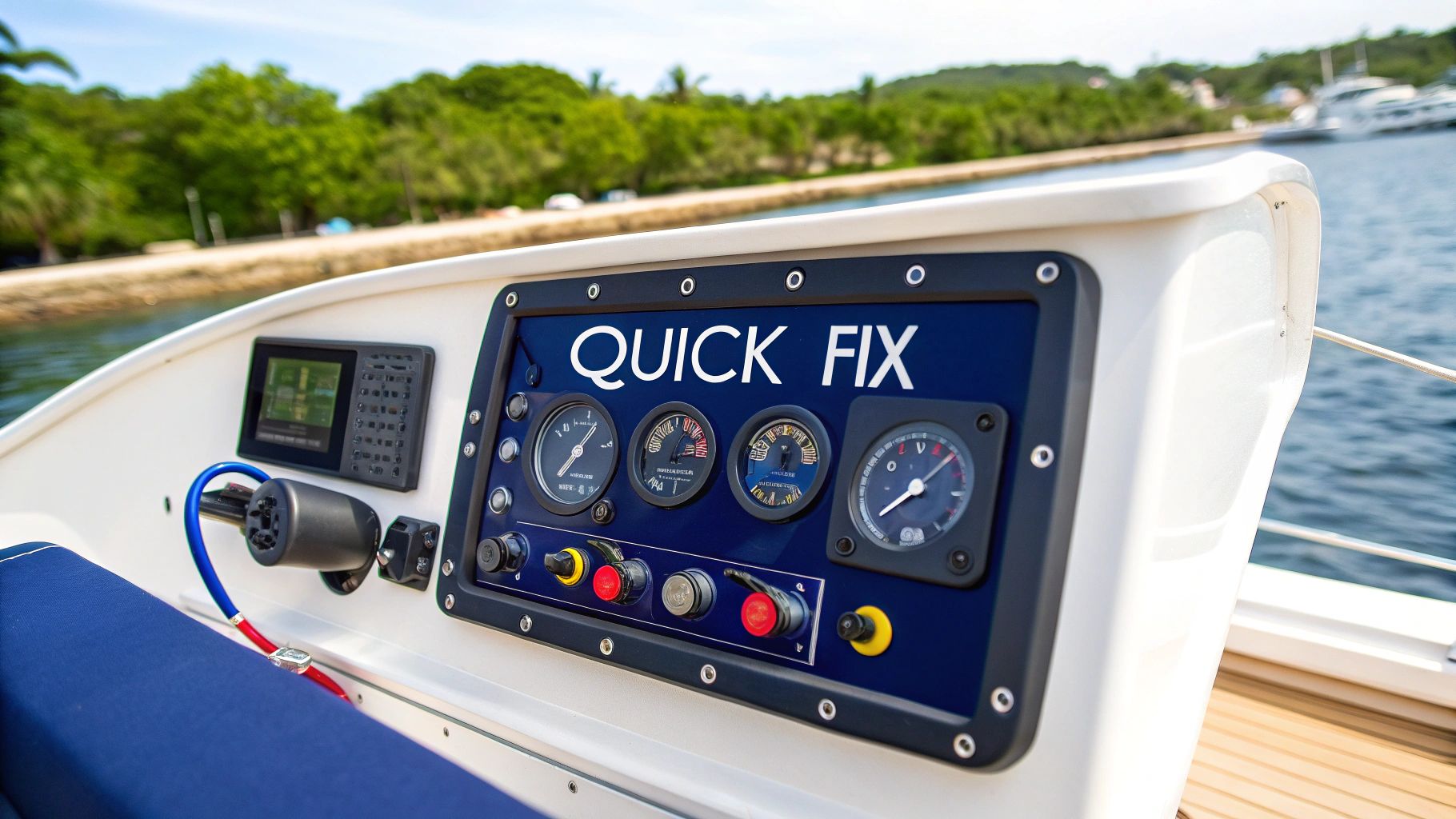The Evolution of Outboard Engine Controls

Early outboard engine controls relied on mechanical systems. This meant a direct, physical link between the helm and the engine. While these systems were simple and durable, they often required considerable effort to operate, especially at higher speeds or in choppy water. Maneuvering with stiff levers and cables fighting against the water could be a real challenge.
This physical demand limited both responsiveness and precision in boat handling. Docking, navigating tight spaces, and maintaining precise speeds were often difficult.
However, the arrival of electronic controls significantly changed how we interact with outboard engines. This wasn't just about convenience. It fundamentally altered the relationship between the captain and the vessel. Electronic controls brought a level of precision and responsiveness not possible with mechanical systems.
From Cables to Computers: A Digital Leap
The evolution of outboard engine controls has been a journey of technological advancement. A key milestone was the introduction of electronic fuel injection by Mercury in 1987 with the V-6 220 XRi model. This innovation introduced electronic control modules (ECMs).
These ECMs act as the computer brains of the outboard. They enhance engine performance, efficiency, and reliability by allowing for more precise control over fuel delivery and ignition timing. This led to significant improvements in performance and fuel economy. Over time, these electronic systems have evolved to include sophisticated digital displays, giving boaters more control over their engines. Learn more about the evolution of outboards
Digital controls also paved the way for integration with other onboard systems. This allows for features like synchronized throttle and shift control for multiple engines. This simplifies operation and improves handling, especially for larger boats. Imagine a single control panel managing multiple engines at once, keeping them working together seamlessly. This synchronization reduces the captain's workload and boosts overall efficiency.
The Modern Helm: A Command Center on the Water
Modern outboard engine controls are sophisticated command centers. They place a wealth of information and control at the captain's fingertips. Digital displays provide real-time data on engine performance, fuel consumption, and other critical parameters.
This real-time feedback allows captains to make informed decisions and optimize their boating experience. They can monitor fuel efficiency and adjust speed to maximize range, for example. These advancements have made boating safer, more efficient, and more enjoyable.
The shift towards digital integration has also brought a new level of customization. Boaters can now tailor their control systems to their individual needs. This includes customizing display layouts, setting preferences for different operating modes, and integrating with other onboard electronics.
These advancements show the continuous progress in outboard engine control technology. They point toward a future where boating is even more intuitive, efficient, and fun.
How Outboard Engine Controls Actually Work

Modern outboard engine controls are much more sophisticated than simple levers and cables. They are complex systems designed to translate your commands at the helm into precise engine responses. This process begins when you adjust the throttle and shift, converting your actions into signals the engine can understand. The method of conversion depends on whether your outboard uses a mechanical or digital control system.
Mechanical Outboard Engine Controls
Mechanical systems rely on a straightforward arrangement of cables and linkages. When you move the throttle, a cable directly connected to the engine's throttle valve is either pulled or released. This action directly controls the flow of fuel and air into the engine, thus regulating its speed. The shift lever operates similarly, using a cable to engage the different gears in the outboard's lower unit. These mechanical systems are valued for their simplicity and robust durability.
Digital Outboard Engine Controls
Digital outboard engine controls, often referred to as drive-by-wire systems, replace physical cables with electronic signals. In these systems, sensors translate your throttle and shift adjustments into digital information. This information is then transmitted to an electronic control module (ECM), which acts as the central processing unit for your outboard engine. The ECM interprets the signals and sends commands to actuators that control the throttle and shift mechanisms electronically.
The Role of the Electronic Control Module (ECM)
The ECM is a vital component of modern digital outboard engine controls. It receives input from various sensors, processes the data, and then sends instructions to the engine. This allows for extremely precise control over essential functions such as fuel delivery and ignition timing. One key benefit of the ECM is its ability to enable automatic engine synchronization, ensuring multiple engines work together seamlessly. This feature significantly improves the handling and efficiency of vessels equipped with twin or triple engine setups. Digital systems also provide real-time feedback to the operator via digital displays, showing important information like engine RPM, fuel consumption, and temperature. For more information on boating in general, see our guide on How to Master Various Boating Aspects.
Throttle and Shift Mechanisms
Whether your outboard utilizes a mechanical or digital control system, the ultimate goal is to regulate the throttle and shift gears. The throttle controls engine speed by managing the fuel and air mixture, while the shift mechanism engages and disengages gears, controlling the direction of the boat (forward, backward, or neutral). In older mechanical systems, these functions are directly linked to the controls at the helm. However, in digital systems, electronic actuators receive commands from the ECM. This electronic interface allows for a level of precision and responsiveness that surpasses traditional mechanical setups, resulting in a smoother, more efficient boating experience, especially when docking or maneuvering in tight quarters. Understanding these core functions is essential for any boater, from troubleshooting basic issues to choosing the right control system for their boat and boating style.
To help you better understand the differences between these control systems, let's take a closer look at the advantages and limitations of each:
The following table summarizes the different types of outboard engine control systems:
| Control System Type | Operating Mechanism | Key Features | Best For | Limitations |
|---|---|---|---|---|
| Mechanical | Cables and linkages | Simple, durable, direct control | Smaller boats, basic applications, boaters seeking simplicity | Less precise, can require more maintenance over time, limited features |
| Digital (Drive-by-Wire) | Electronic signals and actuators | Precise control, enhanced features (e.g., engine synchronization, digital displays), improved responsiveness | Larger boats, multiple engine setups, boaters seeking advanced features and performance | Higher initial cost, requires specialized diagnostic tools |
This table highlights the key differences between mechanical and digital control systems, helping you choose the best fit for your boating needs. While mechanical systems offer simplicity and durability, digital systems provide greater precision and access to advanced features. The best choice depends on factors such as boat size, desired features, and budget.
Digital Revolution in Outboard Engine Controls

Digital technology has drastically changed outboard engine controls. Simple mechanical systems have become sophisticated, integrated command centers. This shift has significantly changed how boaters interact with their vessels, providing new levels of control and awareness on the water. This translates to a more responsive, efficient, and safer boating experience. These advancements offer substantial benefits that extend beyond mere convenience.
Enhanced Control and Responsiveness
One of the most significant benefits of digital outboard engine controls is the improved responsiveness. Electronic throttle systems react instantly to input. This provides much finer control than traditional mechanical cables.
This precision allows for smoother acceleration, quicker deceleration, and more accurate maneuvering, especially in difficult conditions. Docking in tight spaces, for example, becomes significantly easier with the precise control of digital systems. This improved control increases safety and confidence on the water.
Digital controls also enable features like engine synchronization. This is especially helpful for boats with multiple outboards. It automatically adjusts the throttle and shift of each engine, ensuring they work together seamlessly. This eliminates the need for constant manual adjustments and creates more balanced and efficient performance. The captain can focus on navigation and safety.
Real-Time Data and Improved Awareness
Digital outboard engine controls include integrated digital displays. These provide a wealth of information about engine performance and vessel operation. This real-time data gives boaters more awareness of their vessel's status. This includes information such as fuel consumption, engine temperature, RPM, and other essential parameters.
Modern outboards come with digital displays offering real-time data. These displays allow for intuitive adjustments to engine settings. Systems can include features such as sonar, chart plotting, and even suspension control. Boaters gain enhanced control and situational awareness. Companies like Yamaha have focused on partnerships with boat builders to enhance their outboard systems’ visibility and reliability.
Digital controls have improved performance and contributed to a safer and more engaging boating experience. This reflects a broader trend towards technological integration in the marine industry. Learn more about the history of outboard motors here. This heightened awareness allows boaters to optimize performance and fuel efficiency, and identify potential problems early on. Integration with other onboard systems, such as GPS and sonar, provides a comprehensive view of the surrounding environment.
Increased Fuel Efficiency and Safety
Digital control systems allow close monitoring and adjustment of engine parameters. This leads to improvements in fuel efficiency. By optimizing engine performance based on real-time data, boaters can reduce fuel consumption, extend their range, and lower operating costs.
This precise control also increases safety, particularly in challenging weather. The immediate response of digital throttle and shift leads to faster reaction times, better maneuverability, and avoidance of potential hazards. These safety features benefit newer or less experienced boaters.
The digital revolution in outboard engine controls has created a more controlled, efficient, and safer boating experience. These advances empower boaters with greater knowledge, control, and confidence on the water.
Choosing the Perfect Outboard Engine Controls

Picking the right outboard engine controls can make a world of difference in your boating experience. There’s no single perfect solution for everyone. The best choice depends on several things, like the size of your boat, what you typically do on the water, and how much you want to spend. Let's break down these factors to help you make a smart decision.
Matching Controls to Your Vessel and Activities
The ideal controls will change depending on what kind of boat you have and how you use it. A small fishing boat, for instance, might be fine with mechanical controls. But a larger cruiser or a boat used for watersports will likely benefit from the precision and features of digital controls. This is because larger boats and those used for activities requiring precise maneuvering, like watersports, need the responsiveness and integrated features of digital systems.
Another thing to consider is how many engines you have. If you're running multiple outboards, digital controls with engine synchronization can really simplify things. This synchronization takes away the need for constantly adjusting each engine individually, which can be a big help in tricky situations or for less experienced boaters.
Compatibility and Budget Considerations
Before you buy new controls, it's essential to make sure they're compatible with your current engine and other onboard systems. It's important to do your research and confirm the controls are designed to work smoothly with your specific engine model and other electronics. This will avoid integration problems later and make sure everything works together.
For example, if you want to add joystick steering or autopilot, double-check that the controls you pick support these features. For more information on boat systems, check out our guide on How to Master Various Boating Aspects. Your budget matters too. Mechanical controls are typically less expensive than digital systems. But digital controls can offer long-term value because of features like better fuel efficiency and less maintenance.
To help you choose the right controls for your needs, take a look at the Outboard Control Selection Guide below. It provides a general overview based on boat type and typical usage.
The following table offers a general guide for selecting appropriate outboard engine controls:
| Boat Type/Size | Typical Usage | Recommended Control Type | Essential Features | Price Range |
|---|---|---|---|---|
| Small fishing boat | Casual fishing, day trips | Mechanical | Basic throttle and shift | $500 - $1,500 |
| Medium-sized runabout | Watersports, cruising | Digital or Mechanical | Trim control, engine synchronization (if multiple engines) | $1,000 - $3,000 |
| Large cruiser, pontoon boat | Extended cruising, entertaining | Digital | Joystick steering compatibility, autopilot integration, advanced display features | $2,500+ |
| Multi-engine setup (any size) | Enhanced control, synchronized performance | Digital | Engine synchronization, throttle and shift control for all engines | $3,000+ |
This table summarizes the key features and price ranges for different control types. Remember, these are just guidelines, and the best choice for you will depend on your specific needs and preferences.
By considering these factors – boat type, usage, compatibility, and budget – you can choose controls that truly enhance your boating experience, improve safety, and provide lasting value. This ensures you get the most out of your time on the water.
Installation and Maintenance Secrets Revealed
Proper installation and diligent maintenance are essential for getting the most out of your outboard engine controls. Your owner's manual is a great starting point, but real-world experience offers valuable insights. Let's explore some installation and maintenance secrets from experienced marine technicians that can save you time, money, and headaches.
Installation Best Practices
-
Precise Mounting: Mounting the control box securely and ergonomically is crucial. Use a high-quality marine-grade sealant like 3M 4200 to prevent water intrusion and corrosion. Consider the helm layout and the captain's reach for comfortable and effective control.
-
Cable Routing: Route cables carefully for smooth and reliable operation. Avoid tight bends or kinks that can restrict movement or cause wear and tear. Secure cables with clamps and ties to minimize vibration and chafing. This prevents future control problems.
-
Connection Integrity: Double-check all electrical connections. Ensure they are tight and properly crimped. Use marine-grade connectors and heat shrink tubing to protect against corrosion. Taking extra time here can prevent significant electrical issues later.
DIY Maintenance That Makes a Difference
Regular maintenance can dramatically extend the life of your controls. Here are a few key tasks you can handle yourself:
-
Lubrication: Lubricate all moving parts, including cables, linkages, and pivot points regularly. Use a marine-grade lubricant like CRC 6-56 Marine Formula designed for the harsh marine environment. This keeps your controls operating smoothly and prevents corrosion.
-
Cable Inspection: Inspect control cables for fraying, kinking, or corrosion. Replace damaged cables immediately to avoid failures on the water. Your cables are like the lifeblood of your control system; their health is vital.
-
Control Box Cleaning: Keep your control box clean and free of debris. Use a mild detergent and fresh water to remove salt and grime. This prevents corrosion and ensures proper function of buttons and switches.
Troubleshooting Common Issues
Even with meticulous maintenance, problems can still pop up. Here's a quick guide:
-
Stiff Controls: Stiff controls usually point to lubrication problems or cable damage. Check for kinks or binding in the cables. Lubricate moving parts with a marine-grade lubricant. If the problem persists, you might need new cables.
-
Erratic Operation: Erratic behavior suggests a problem with the electrical connections or the control module. Check connections for corrosion or looseness. If connections are fine, consult a qualified marine technician to diagnose the control module.
-
No Response: If your controls are unresponsive, start by checking the battery connections and the main power switch. If there's power, the problem likely lies within the control system and needs professional attention.
By following these installation and maintenance tips, you can keep your outboard engine controls reliable and responsive for years. These proactive steps can help prevent costly repairs and unexpected downtime, so you can enjoy your time on the water worry-free.
Future Trends in Outboard Engine Controls
The world of outboard engine controls is constantly changing and improving. New innovations are set to reshape how we interact with our boats, making them easier to use, more efficient, and better for the environment. From better connectivity to more customization, the future of outboard engine controls looks promising.
The Rise of Smart Controls and Connectivity
Connectivity is key for outboard engine controls. Imagine a system that diagnoses problems before they become serious, or one that adjusts engine performance based on current conditions. This is what smart outboard engine controls can do. These systems use sensors and data analysis to improve performance, fuel efficiency, and reliability.
Some manufacturers, for example, are developing systems that work with weather forecasts and GPS data. This allows the engine to anticipate changes and adjust accordingly, saving fuel and reducing emissions. These smart systems can also warn boaters of potential issues before they lead to breakdowns. You might be interested in: How to master various boating aspects.
Sustainability and Environmental Considerations
Environmental awareness is a major force behind innovation in outboard engine controls. The market has changed due to improvements in control systems. Two-stroke engines were once popular due to their simplicity. However, advancements like electronic fuel injection have made four-stroke models more appealing and environmentally friendly. This has resulted in more sustainable options for boaters. Learn more about outboard motor history here.
Manufacturers are focusing on developing controls that lessen environmental impact. This includes features like optimized fuel mapping and advanced emission control systems. Some manufacturers are even looking at alternative fuels and hybrid engine designs. This commitment to sustainability will be vital for the future of boating.
Personalization and Customization
The future of outboard engine controls will also be more personalized. Imagine customizing your control panel, selecting the data displayed, and setting the system to suit your boating style. This level of customization is becoming more common. Some systems already allow for personalized profiles, saving individual preferences for throttle response, trim settings, and display layouts.
This shift toward personalization lets boaters create a truly customized experience, setting the controls to their needs and preferences. Whether you're fishing or cruising, you'll be able to configure the controls to fit your boating style.
Intuitive Operation and Enhanced User Experience
Ease of use is essential. Future outboard engine controls will be even more intuitive. Touchscreen displays, voice control, and simpler interfaces will become more common. This will make the technology easier to learn and make boating more accessible to everyone.
The goal is to make interacting with the engine as effortless as possible. This lets boaters focus on enjoying their time on the water.
Ready to experience the future of fueling? CLiX Fueling Solutions offers a stress-free and spill-free way to fuel your boat. Our innovative system automatically stops when your tank is full, preventing spills and protecting the marine environment. Visit CLiX Fueling Solutions today to learn more and upgrade your fueling experience.











